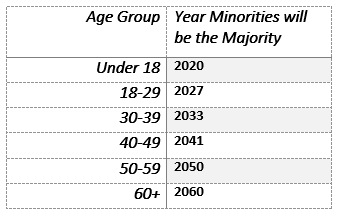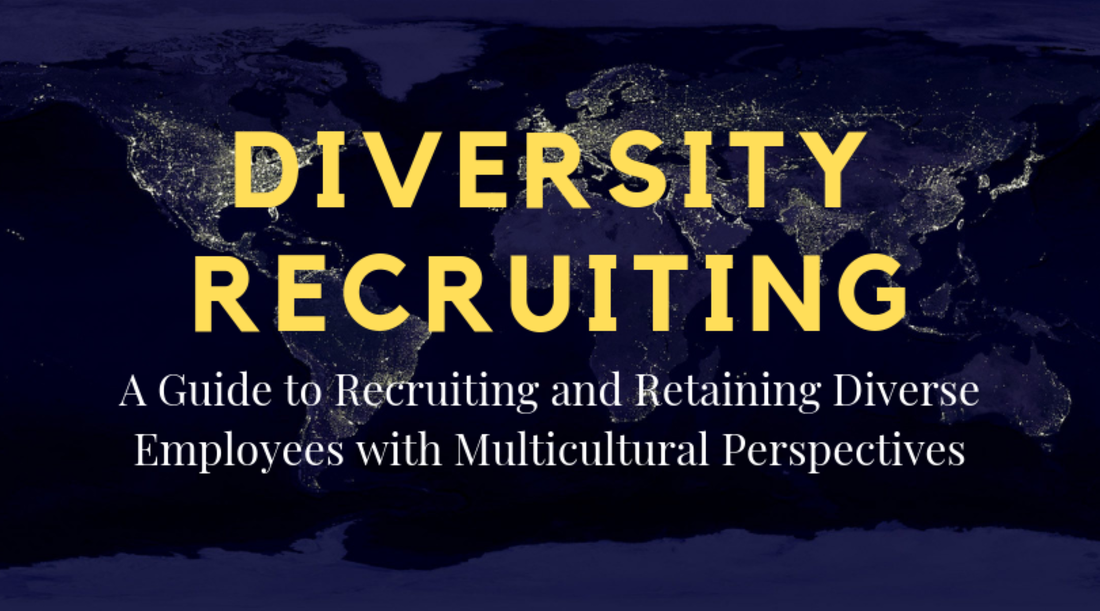|
When we reflect back to 2010 the world looked very different from what it does today, almost ten years later. We have seen more technological and cultural shifts in this decade than any that came before. The world seemed to move so fast around us, and diversity quickly became the buzzword of the decade. Let’s take a look at how diverse voices found their way into the spotlight in the last ten years and how these same voices are going to continue to catapult us into the new decade of diversity, inclusion, and equity.
Age More recently in the last few years, Gen Z has proven that age really is just a number. Seen as the generation of young activists, Generation Z (1995-2015) have found their voices in activism and standing up for what’s right. The March for our Lives in 2018 was a student led initiative started by the students in the Parkland shooting to urge policy makers for gun control. This year, Greta Thunberg was named Time’s youngest Person of the Year for her activism to prevent climate change. Millennials, step aside for the new generation because Gen Z is leading the way in social media, activism, education, and consumerism and making sure their expectations for diversity, ethicality, and sustainability are met by every brand they engage with. Women’s Empowerment #MeToo. The most wide spread and impactful social media movement of the decade. Women took to social media to support each other and dispel the stigma around speaking and reporting sexual assault. The movement created winding change in both feminine and masculine spheres of influence as celebrities openly shared their stories of survival and masculine brands and celebrities debunked outdated stereotypes of toxic masculinity and “boys will be boys” culture in exchange for true allyship and understanding. Equally empowering, the Team USA’s women’s soccer team successfully fought for equal pay to their male counterparts after winning the Women’s World Series proving that gender has no limitations. Needless to say, 2020 is the decade of the woman. Say goodbye to locker room culture and the men’s club because women are coming in strong. Gender & Sexuality This decade saw the rise of the Gender Revolution in National Geographic and huge victories for the LGBTQ community. The 2015 Supreme Court case Obergefell v. Hodges made marriage equality the law of the land as LGBTQ couples gained the right to marry under the law. Facebook, Twitter, Tinder, and other social media sites re-evaluated their definition of gender to include 58+ gender terms. And what was the 2019 Mariam-Webster Dictionary’s word of the year? The non-binary, gender-neutral, pronoun “they” as used by Sam Smith and countless others across the country. In the new decade we will continue to see wider forms of non-binary or genderless expression in fashion, beauty, and self-representation as employees continue to observe and celebrate their true authentic selves. Race and Ethnicity Representation was a big theme of the decade as consumers demanded to see themselves represented in media, advertising, and art. The need for diverse racial representation led to the success of prominent African American films such as Us and Black Panther and the cult followings of English language Telenovelas such as Jane the Virgin and Devious Maids. Consumers in this decade did not tolerate the omission of People of Color as seen in the 2015 Oscars awards hashtag #OscarsSoWhite. Brands also jumped onto the call for racial diversity from Coca-Cola’s “America the Beautiful” ad or Nike’s support of Colin Kaepernick. The next decade, brands will follow the precedent Rihanna started with Fenty Beauty by incorporating all skin tones into leadership, marketing, and advertising to create representation. Ability Athletes, academics, and activists all exemplified time and time again that in the last ten years people with disabilities were stronger and more vocal than ever before. In 2012, Oscar Pistorius became the first double-leg amputee to participate in the Olympics inspiring amputees across the world. Two years later people around the world began pouring buckets of ice water on their heads to raise awareness for ALS, a disease that would later take the life of the most influential scientists of our generation: Stephen Hawking. Sesame Street introduced the first autistic character on the show in 2017 to normalize different ways of behavior and ways of engaging the world. In the new decade with so many prominent voices empowering disabled individuals, stigmas around disabilities will continue to decrease as many choose to embrace and disclose disabilities to their employers, families, and friends who in turn need to learn ways accommodate all forms of how people interact with the world around them. The New Decade: 2020 The last decade has seen consumers and influencers loudly making calls to action and the brands and causes that succeeded this decade took those calls to heart. The brands that were successful saw the social and cultural shifts that were happening around them and implemented them both in and out of the office. However, the brands of 2020 are going to have to be more focused on DEI than ever before. Unlike the brands of the 2010’s, brands in 2020 will have to do more than simply recognize diversity, they are going to have to embrace it and empower diverse voices to make decisions that will impact a diverse set of consumers. 2020 will not be a homogenous decade and neither can the brands that will succeed. DCAProSearch has been at the top of this movement since for over two decades and we will continue to partner with brands to recruit diverse talent that speaks to the diverse audience of 2020. From everyone at DCAProSearch thank you for a great decade and we wish you the best in 2020.
3 Comments
In the world of business, everything is measured. The same goes for our hiring practices. Diversity and inclusion cannot be an initiative that is only spoken about. As Sophie Bellon, Chairwoman of Sodexo, tells us “what gets measured gets done.” The same goes for our hiring practices. HR and hiring managers should be establishing diversity goals to encourage diverse hiring practices throughout the company. However, although 42% of the population self-identifies as “multicultural”: African-American; Hispanic; Asian; Disabled or LGBTQ+, an AIMM’s Multicultural Benchmark Study shows that only 16% of marketers imbue their outreach with cultural insights aimed at these audiences. AIMM is a committee formed by the ANA (Association of National Advertisers)and is short for Alliance for Inclusive and Multicultural Marketing.
Human resources, top level executives, hiring managers, and employees should make it a priority to sit down and define what diversity looks like within the company. Hold a town hall or fireside chat so all members of your organization can get involved in defining what their workplace will look like and what improvements should be implemented in the hiring process. Here are some tips on how companies throughout the country have set and achieved their goals. Match the Demographics of the Country With countless different voices in the country, it can be difficult to ensure that all are represented within the organization. That is why many companies strive to match the racial demographics of the country to ensure all voices are present in proportion to the population. Specifically with Gen-Z consumers, younger consumers are drawn to companies that are representative of the diversity that exists within the world and want brands that demonstrate they are leading the march serving all consumers. Diversify all Levels of Management In addition to diverse hiring practices, make sure that you continue to empower different voices within the organization from interns to C-Suite executives. Diversity will not be effective if your diverse employees are concentrated at the bottom levels of management. Having diversity at all levels of your corporation allows for the dissemination of experience and solutions at all levels that will be integrated for an enhanced problem solving capacity for your business. Invest in a Chief Diversity Officer Consider your Chief Diversity Officer your accountability partner. With his/her team, the CDO will measure the effectiveness of your diversity, equity, and inclusion (DEI) initiatives and find areas to improve diversity practices by creating a report for top management every quarter. Although it’s possible to achieve diversity without a CDO, remember that achieving DEI in a company is a sensitive task that can sometimes lead to frustration if not incorporated correctly. Therefore, a certified and experienced CDO will help aid in the implementation of strategies and help you get the most of the benefits of diversity. Strive for Diversity and Inclusion Awards Various awards and recognitions exist for companies that have excelled in their DEI practices. Such awards include the Human Rights Campaign's Corporate Equality Index, Bloomberg's Gender Equality Ranking, NASSCOM Corporate Awards for Excellence in Diversity and Inclusion among various other awards. Although these awards shouldn’t necessarily be your motivation for implementing DEI strategies they represent a good benchmark to how well you are achieving your goals. Diversity Tip: Know the difference between a goal and a quota. Although diversity should be a goal for all growing companies, it is important that it is not forced on business leaders as a mandate from HR, but rather an attitude that is adopted by all managers throughout the company. This will lead your leaders to create goals as opposed to filling quotas. A goal is created because hiring managers recognize the value of diversity and thus they encourage diverse hiring practices. Whereas, a quota forces hiring practices without valuing what diverse talent brings to the table. Diversity and inclusion is an essential part to growing your business to reflect the modern day workforce and the modern day consumer. More than ever, consumers expect businesses to be diverse, equitable, and inclusive and will reward businesses who represent these values. While it can be tricky, DEI is well worth it and pays off in consumer loyalty and brand recognition. At DCAProSearch we have been leading the way in diversity recruiting finding diverse talent for companies and agencies for over 20 years and we will continue to shout the importance of DEI from the rooftops until diversity, equity, and inclusion are recognized as the standard. We have been, and will always be, your diversity recruiter. Please say it’s not so! Analysts again are warning of an upcoming recession due to recent market behavior and various financial factors. Whether you believe their assessment of the economy or not, the fact is we are due for a recession at some point. The American economy is cyclical in nature, and considering we are in the longest bull market in history, a recession seems to be due sooner rather than later. I am not speaking as an economist or financial adviser, but as a recruitment partner who has weathered these economic fluctuations with my clients in the past. History has proven that there are ways to weather a recession, and maybe even thrive until the market starts to pick up again.
1) Hire the Perfect Team Early We are in a booming economy right now. Use it! Build your dream team now that way you can increase your budget and secure funding now before it is too late. Once a recession hits, your ability to ask the company for a bigger budget to hire someone you need is almost impossible. On average, budgets will remain stagnant or even decrease a little bit. However, if you go into a recession already having built your recession-proof team then their salaries have already been accounted for in the budget planning meetings and their job should be secure going forward. This being said, don’t go overboard by hiring people you don’t need or whose jobs are too similar. This is when you’ll be forced to slim down and let good people go. 2) Prioritize Your Marketing During a recession, marketing is often the first thing to go. Marketing is essential in a recession to keep your brand remembered and fighting for consumers. When you decrease marketing and your competitors don’t, you have already lost consumers. However, if you keep marketing strong while your competitors lapse you have an opportunity to win market share. It is possible to grow during a recession, and marketing is the key to doing so. Instead of cutting marketing entirely, create a ranking for campaign importance. The most important and effective campaigns remain funded while other costly or overly risky campaigns get put on hold if the market goes sour. 3) Add Value not Price A big trend we saw during the 2009 recession was that prices go up and never come back down. While consumers may choose your brand for a number of reasons, you can be sure that during a recession price is a huge factor of if they keep choosing you or try someone new. Increasing your price will turn away loyal consumers who are looking for a cheaper alternative, therefore boosting your competitors and making you lose market share. Instead, focus on adding value that doesn’t cost much such as excellent customer service, satisfaction guarantees, and loyalty programs to convince your consumer that your existing price is worth it. 4) Develop Short Term Goals A volatile market can make long term goals tricky. The economic conditions that exist at the beginning of a recession may not exist in a month, or even a week, after. Therefore, make your goals reflect the volatile nature of the market by adopting challenging yet achievable short term goals. A 30-day goal that can adapt to market volatility from month to month is a good way to keep realistic expectations and act quickly when the market begins to change. 5) Utilize Partnerships You aren’t the only one going through the recession. Every one of your partners is feeling it too. Incorporate Co-op marketing campaigns with retailers or other brands. You marketing dollars will be stretched by bringing partners into a campaign. You should focus on preserving your partnerships because you and your partners are able to do a lot more together than each of you can do alone. To go back to economics 101, like nations, companies have comparative advantages. An advertising firm can do advertising for much less than it would cost you. Similarly, a recruiter can recruit talent for much less than it would cost you. Therefore, by utilizing each of your partners' specialties each of you are able to benefit from gains of trade and produce much better than you would be able to alone. A recession can be nerve-wracking but you will get through it. Make preparations now before you are left scrambling when the market begins to slow. It may be in a month, a year, or 5 years but it is always better to be ready for anything. DCAProSearch is proud to be your recruiting partners throughout good and bad, and we are always ready to help you build your corporate dream team to help you ride out any storm.  Diversity in the workplace has been praised as not only being ethical but a smart business decision. However, the main question that stumps passionate diversity advocates is, “How will investing in diversity make us money?” In, a perfect world, arguing that investing in diversity is the ethical thing to do would be enough for any hiring manager. Unfortunately, most of us live in the business world where nothing is done unless it helps raise the bottom line, and now it is up to you to prove that diversity does exactly that. Admittedly, it’s a difficult argument to quantify. Saying that adding diversity initiatives would add X amount of dollars to the bottom line would be oversimplifying the benefits of diversity because the exact benefits are hard to trace. Lucky for you, we’ve put together the business case that you have been looking for. Whether you are a skeptic of diversity or a diversity devotee, the numbers prove that diversity works. Diversity is an Expectation for Top Talent Job seekers are beginning to expect companies to have a diverse workforce and value diverse employees. According to Glassdoor, 2 in every 3 active and passive job seekers said that a diverse workforce is an important factor when evaluating companies and job offers. According to a Glassdoor study, when asked how important a diverse workforce is when evaluating companies and job offers 67% of respondents indicated that diversity was important or very important to their decision. When broken down, the numbers were even higher among women (72%), African Americans (89%), Hispanics (70%), Asians (80%), and millennials (86%). However, nearly 6 out of 10 employees think their company should be doing more to increase diversity. Therefore, by not investing in diversity efforts you are actively persuading top talent to look elsewhere for the diversity of thought they are looking for. Higher Financial Performance McKinsey & Company published a study in 2018 correlating higher gender and ethnic diversity to higher earnings before interest and taxes (EBIT). The study concluded that companies in the top quartile of gender diversity had a 21% higher likelihood of above-average financial performance than companies in the bottom quartile. Similarly, companies in the top quartile of ethnic diversity saw 33% higher likelihood of having above-average financial performance than companies in the bottom quartile. This is in part to diverse teams having more innovative R&I, enhanced group think, greater insight into real-world perspectives, quick access to cultural ambassadors, new product concepts, and introduction to new markets. Greater Innovation Boston Consulting Group (BCG) came out with a similar study concluding that there existed a statistically significant correlation between the diversity of management teams and innovation. Companies that had higher diversity within management saw 19% higher innovation revenue than companies with below-average diversity. A Harvard Business Review study tied this correlation to the fact that diverse teams understand diverse market needs, leading to more relevant product development that meets real-world needs versus non-existent problems. A 2017 Harvard Business Review report found that teams with higher cognitive diversity were 53% more effective and efficient in completing cognitive tasks than less diverse teams. From being able to identify sore spots in brand marketing to revealing new product and research opportunities, multicultural talent brings new perspectives and solutions. Racial Minorities are only Getting Larger The Brookings Institute estimates that minorities will make up the majority of the United States population by the year 2045. The Hispanic community is set to see the fastest growth in population. However, all minority groups are forecasted to see steady growth as well. By 2045, whites will make up 49.7% of the United States population, while Hispanics will make up 24.6%, African Americans 13.1%, Asian’s 7.9%, and all other racial minorities 5%. If we look at the racial demographics by age in the table, minorities will be the majority of the workforce even sooner. Therefore, by delaying diversity initiatives you are isolating young talent and simply delaying the inevitable. Not only is diversity the right thing to do, but it would be a mistake to ignore or delay the benefits of diversity in the workplace. Although many skeptics still believe the financial benefits of diversity are non-existent or not proven, hundreds of companies around the world have proven that diversity initiatives are beneficial, if not necessary, to grow in today’s consumer-driven market. That is why DCAProsearch is dedicated to diversifying the marketing and advertising space with top diverse talent because we believe that diversity isn’t only the right thing to do, it is the way of the future. Resignations happen all the time. People find better opportunities, life happens, and people move on for all sorts of reasons. Good talent leaving isn’t something to be alarmed about, but when multiple resignations occur in close proximity to each other it is time for alarm. A mass exodus of talent can happen for a number of reasons: loyal employees following a good leader, an ethical scandal that has shaken the moral compass of employees, a bad financial report that tests the confidence in the future of the company. Whatever the reason, the top priority for top executives and HR should be to limit the number of employees who jump ship to avoid losing good talent. De-escalate the conflict quickly and most times the company will come out stronger on the other side.
1) Don’t Counter. Listen and Ask When you see your best employees leaving, your instinctual move is to create a counter-offer to make them stay. It makes sense, give them an offer that you think they can’t refuse. However, don’t be so hasty. At the end of the day, a counter-offer is a power play and an unwise one at that. Most counter-offers are like throwing a dart in a dark room. Most will offer a raise or promotion, but few will hit the reason the employee is actually leaving. The reality is your employee is the one in power, and you shouldn’t exert your power to sway their decision until you know what it is they need. Instead of designing a counter that you think would sway them, listen to the reasons they are leaving and ask if there is anything that could influence their decision. 2) Call your Recruiter Immediately Whenever you battle a crisis there is always a risk for casualties. You cannot be so naïve to think that everyone will stay with you. Identify loose links and call your recruiter immediately so they can start a search for replacements. This minimizes the loss to the company and to the morale of your employees if you do lose some talent. Hiring a replacement quickly after you lose talent keeps your employees from feeling overworked for extended periods of time, fills the empty desk feeling of the office place, and brings new ideas to a stagnant workplace that can actually serve to improve the business. 3) Secure Top Talent People follow people, and there are some people you simply can’t afford to lose. You have to act quickly to make sure top talent has no inclination of leaving the company or taking other talent with them. Talk to them personally out of the office to eliminate any intimidation or pressure they may feel when talking about such issues with their boss. Make them feel comfortable and ensure them about the future of the company and the future of their career. Sometimes it may even be necessary to offer them incentives to stay such as more vacation time or a raise to sweeten the deal, but it’s worth it if it means they’ll stay. 4) Promote Worthy Employees No one is going to leave a job they just started. If you are nervous about employees following a leader then make them a leader, but only if they are ready. On average, an employee will wait at least one to two years after starting a new job to even consider leaving their position. Promoting worthy employees will inspire loyalty to the company, and even keep lower-level employees from jumping ship because they see their colleagues staying and thriving. 5) Create a Challenge The saying goes that an idle mind is the devil’s playground. From a career standpoint that rings even more true. Ambitious employees don’t like to feel stagnant, and no overachiever wants to leave loose ends. Therefore, by constantly challenging your employees to find new solutions, reach further, and follow unique ideas you are inspiring them to remain with their jobs regardless of company politics, changing leadership, or newsroom events. Keeping your employees engaged and invested in their work gives them a reason to stay on even through turmoil that may have demotivated them in slow seasons. An exodus of top talent can have far-reaching effects within the company, but quick action can easily stop a crisis if you take the right steps. However, the fact is at some point or another you will lose good talent. Keep DCAProSearch in the loop to minimize the effects of losing good employees and find talent that may even exceed what you thought possible before. Any crisis can be averted with good planning. Do you have a plan? When it comes to what an executive recruiter does, not many people can give you a solid definition. If you ask a client, they will tell you that we find them top tier talent for their hard to fill positions. If you ask a candidate, they will tell you we find them jobs. However, if you ask a recruiter. we will tell you that we create an ever growing talent network consisting of skilled active and passive candidates that we use to uniquely identify top candidates within that network who meet and exceed client talent needs.
Because clients and candidates alike can’t identify exactly what an executive recruiter does for them, they also miss out on so many benefits that we are able to provide. If you think that you are only getting one service out of your recruiter, think again because we are able to provide so much more. We are experts in our industry, and clients and candidates alike should be utilizing their relationship with a recruiter for more than just finding new talent or a new job. Client Tips Recruiter as an Industry Insider Having a recruiter on your side is like trading with insider knowledge, except legal. We are always on top of industry news and are tracking trends on the daily basis. After all, the signs of big industry news can always be traced back to what companies are hiring, who they are hiring, and who they are letting go. Recruiters know how to read the tea leaves, all you have to do is ask. Recruiter as a Confidant While we are ready to tell you the news on the industry, we will never spill your news. We are proudly bound by client privilege, which means you are able to confide in us about upcoming changes in leadership, a new department opening up, or other office news that you need talent for. We then are able to silently seek out candidates for you to look at before the news even breaks. Recruiter as an Ambassador Your job boards are likely to only bring you lackluster candidates who have been sending their resume to anyone who will take it. However, a recruiter is your ambassador to the passive candidate network. These are professionals who are already proven and successful in the prime of their career, but who are not actively looking. Let us be your ambassador instead of relying on outdated resume books and job boards. Recruiter as a Hiring Guide Believe it or not, according to leadershipIQ a staggering 46% of new hires are considered mis-hires within the first 18 months. The reason, faulty hiring practices. An executive recruiter can guide on improving how you screen candidates and lead you to the right choice. For example, at DCAProsearch we created our Diversity Recruiting Guide to help companies with recruiting and retaining diverse talent. Candidate’s Tips Recruiter as a Magnifier There is a difference between being an applicant and a candidate. You’re an applicant if you simply submit your resume via on online link and hope for a response. With a recruiter vowing for you, you are instead a highly sought after candidate who has more legitimacy in the eyes of potential employers because you are being backed and talked up by a recruiter. Recruiter as a Mentor Who else is going to take the time to sit down with you and go over your resume, formulate a perfect thank you letter, or review interview success tips? When you trust us throughout the entire application process we are there for you to answer any question no matter how dumb it may feel. However, that does come with a catch. The only way we can help you is if you confide in us before, during, and after the hiring process. Why, because the application process doesn’t end with the interview, there are countless other factors you need to know that we can only tell you when you build a relationship with us throughout your career. Recruiter as a Career Guide Would you want to stay held back in the 10th grade even though you’re ready to graduate to 11th? Of course not. However, that is what too many professionals do within their careers. They remain stagnant in one position, not knowing they are ready to move up in their career progression. Recruiters know where you should be in your careers and what you should be seeking as your next strategic move. Ask a recruiter if you have stayed too long, and how you can advance your career. -- About DCAProSearch DCAProSearch specializes in recruiting premium multicultural and general market professionals in advertising and marketing who excel in the contemporary reflection of today's diverse cultural and digital landscape. At DCAProSearch we strive to give our clients the Distinctive Client Advantage, meaning we only present premium candidates that we are certain will strengthen your power teams. Culture Marketing is leading the way, and DCAProSearch understands that these changes require a unique talent. This is why our executive recruiters are dedicated to finding professionals with experience and passion in multicultural advertising and diversity marketing to target your specific culture market needs. This week DCAProsearch released an all-encompassing 36 page guide about recruiting and retaining diverse talent in order to create a more multicultural workforce. This valuable guide is split into three concise sections that clearly address the state of diversity in the workplace and methods in which hiring managers, HR, and corporate leaders can take to recruit and retain multicultural talent through effective DEI policies. While the full guide is only a thirty minute read, I wanted to provide a quick executive summary for professionals to read on-the-go while commuting to work or taking a quick break from the office. For the full guide feel free to download it here.
A Business Case for Diversity When it comes to business decisions, it all comes down to the numbers, and diversity is no exception. Whether you are a skeptic of diversity or a diversity devotee, the numbers prove that diversity works. McKinsey & Company published a study in 2018 correlating that companies in the top quartile of gender diversity a 21% higher likelihood of having above average EBIT and companies in the top quartile of ethnic diversity had a 33% higher likelihood of above average EBIT. A separate Boston Consulting Group found that there exists a statistically significant correlation between the diversity of management teams and innovation. Companies with higher management diversity saw 19% higher innovation revenue than companies with below-average diversity. The Harvard Review also found that teams with higher cognitive diversity were 53% more effective and efficient in completing cognitive tasks than less diverse teams. Pt I: The Current State of Diversity A common misconception of multiculturalism is that it consists of only racial and ethnic identities. However, multiculturalism consists of various identities from age, gender, sexuality, and ethnicity each of which consists of different cultural norms and values. Having teams that encompass multicultural perspectives has proven to allow companies to innovate R&I, enhance groupthink, foster cultural ambassadors, reach new markets, incorporate real-world perspectives, and design more relevant product concepts. While many companies have already recognized the value in investing in multiculturalism there is still a lot to be done. By 2045, racial minorities will be the majority of the nation. If we look at the numbers by age group, it is even sooner. Minors under 18 will be majority minority as soon as 2020, and twenty year olds as soon as 2027. Although minority communities are growing quickly, corporate America still has a long way to catch up. Out of all Fortune 500 CEO’s only 11 are Hispanic (2.2%) and 5 are African American (1%). There are more Fortune 500 CEO’s name David (4.5%) than there are female Fortune 500 CEO’s (4.1%). The average woman gets paid only $0.78 for each dollar earned by a white man, and women of color make even less with Hispanic women getting the least at only $0.53 per dollar. However, regardless of all the shocking statistics, 41% of managers say they are “too busy” to implement diversity initiatives. To say it bluntly, the state of diversity in America should be viewed as unacceptable for any company that strives to be diverse, equitable, and inclusive (DEI). Pt II: Recruiting for Diversity at Work Diversity has become expected in today’s workplace. According to glassdoor, 67% of job candidates believe that a company having a diverse workforce is an important factor when evaluating companies and job offers, and 57% of employees believe their company should be doing more to increase diversity. Who exactly is responsible for diversity though? The number one answer was hiring managers, followed by the CEO and HR. However, 1 in 4 people believes that employees have a large role to do with recruiting diversity as well. This makes diversity a responsibility for everyone in the company, but especially those who make the hiring decisions. When it comes to achieving diversity, companies have taken varied approaches from matching the diversity of the company to diversifying all levels of management. However, the most effective means were to create a team dedicated to DEI and invest in a Chief Diversity Officer who sits with other top-level executives in making decisions. This officer should be tasked with understanding the current state of diversity within the company and identify areas where diversity needs to be improved. Look at whether diversity is integrated across all departments and leadership levels within the company, and that you are also working with diverse vendors and partners such as multicultural ad agencies or diversity recruiters. When it comes to actually recruiting diverse candidates, there are a number of ways that a company can attract multicultural talent that is more engaging than typical recruiting efforts. Start by diversifying where you recruit for talent. This can mean appearing at Historically Black Colleges or Universities (HBCUs) or Hispanic Serving Institutions (HSIs), sponsoring cultural celebrations, or hosting networking events for minority communities. Additionally, you should be showcasing your diverse talent on social media and award employee referrals to assure diverse talent that your office is a place they can excel and grow. Consider hiring a diversity recruiter to handle your diversity recruiting needs. Diversity recruiters are experienced in finding top diverse talent and abide by the golden rule of recruiting: less is more. Experienced recruiters will only send you a max of 5 resumes rather than overwhelming you with bad candidates, thus letting you make a more informed and attentive decision. Pt III: Retaining Multicultural Talent If your focus is on diversifying your workforce, then you should know that hiring for diversity is not enough. Research by the Association of National Advertisers (ANA) identified four main reasons for diversity efforts failing: management disconnect, macroaggressions, cultural illiteracy, and workplace integration dissonance. To put it more simply, nobody took the time to enforce equitable and inclusive policies. When looking to see whether your company is inclusive look at policies that are relevant to minority employees and ensure that policies address their needs as well. Allow them to submit concerns anonymously, and ensure that all employees are respected as valuable individuals. Various techniques have been utilized around the country by business big and small to foster inclusive work environments. Various companies seek to amplify minority voices by establishing Diversity Group Think Tanks (also known as employee resource groups, ERGs) and encouraging company leaders to mentor lower level employees who have different points of view and perspectives. Additionally, having multicultural teams and management gives employees the ability market brands to multicultural audiences that they are familiar with. To avoid employees not understanding each other’s points of views and backgrounds, invest in cultural brokers on your teams and stress the importance of valuing diverse points of views to ensure that all ideas get heard and considered. It is important to also note that not all employees have the same experiences, skills, or definitions of success. Many employees may benefit from systematic advantages or unacknowledged bias while putting others at a disadvantage. Therefore, it is important to ensure that all policies and practices within the company are equitable. Not to be confused with equal opportunity which provides equal resources and equal assessment to all employees without regard to previous advantages or setbacks, equitable policies stress fairness by recognizing what is/was needed to be successful based on previous skills, tasks, or abilities. Equitable policies focus on acknowledging the role of systematic privilege in the success of some employees over others due to underlying bias and seek to bridge the gap between marginalized groups of employees while addressing and eliminating corporate bias. Companies should provide development resources, such as optional quarterly training, for employees who want to improve their skills and company leaders should diversify performance matrix to recognize various forms of success within the company. Furthermore, establish clear promotion tracks to take out the ambiguity and bias that exist when choosing who gets promoted and standardize pay brackets based on task and level within the company to eliminate large gaps in wages while still allowing room for wage negotiations and raises. Conclusion A successful DEI strategy has proven to be beneficial for the productivity, success, and well-being of your employees. Employees who work in diverse workplaces reported feeling happier and more likely to stay with the company than employees who work in homogeneous environments. Constantly review your DEI practices and hold quarterly meetings with your Chief Diversity Officer to identify ways in which the company can grow and continue to promote DEI. At DCAProSearch we want to share the diversity that exists within the workforce with you and your company. We recognize that diverse mindsets bring about new solutions, new ways of thinking, and new opportunities that make our world better. We thank you for being a part of this movement and challenge you to continue to redefine what it means to be a diverse, inclusive, and equitable company. --- We hope you enjoyed this executive summary of Diversity Recruiting. If you want to get the full 36 page report that goes into detail about the various methods used to recruit and retain diversity plus ways to establish DEI policies in your company download the full report at https://www.dcaprosearch.com/diversity-guide-request.html This is going to be hard hitting on some people, but we need to stop relying on the words Diversity and Inclusion. Why? Because the modern institution of diversity and inclusion allows companies to pat themselves on the back for doing a few things, while allowing them to fall short on the promise they made to minority employees. Simply relying on D&I is limiting us on how we look at recruiting and retaining diverse talent. Although I firmly stand behind the values and meaning surrounding D&I, the institutions companies have created around D&I need to be redefined and expanded to the point where current definitions of diversity and inclusion are considered obsolete.
As an executive recruiter, I specialize in the area of diversity recruiting. However, my goal is for the candidates and clients we match to grow together through their career and business practices. What we've realized is that diversity initiatives alone may not be enough to ensure success. Companies may be able to attract multicultural talent, but when there is no real effort in transforming culture, D&I policies and initiatives that exist to make diverse voices feel valued and respected are bound to fail. Diverse employees will not be able to thrive within the company and will leave the company within a year or two at most. Whereas clients that actively promote, celebrate, and empower diversity, equity, and inclusion (DEI) are where we see our clients and candidates thrive and grow together for years to come. If the culture isn’t already inclusive, you’re not ready for diversity When companies start seriously thinking about diversity and inclusion, it is typically an afterthought based on complaints by unhappy employees, or an exodus of minority employees. Even the name “Diversity and Inclusion” seems to imply that the order is diversity THEN inclusion. However, a design set up on securing vast amounts of diversity talent before establishing a culture of inclusivity is already designed to fail. Before companies seek to expand in hiring diverse mindsets, they should observe the diversity that already exists within the office and ensure that inclusive practices already exist within the workplace for current employees (ex: parents, age groups, gender). When the company then seeks to attract new forms of diversity, they can simply expand on those practice already in place and create new policies as needed rather than scrambling to create something from scratch. ‘Diversity first’ puts the burden on minorities to create inclusion For many companies the reality of ‘diversity first’ has already hit and they are scrambling to create inclusion programs. Unfortunately, this is putting an undue burden on minority employees who have been tasked with either learning to adapt to a non-inclusive environment or with designing inclusion for themselves and others like them in the company. Both of these tasks require minority employees to take on responsibility above and beyond what their job calls for. This can have long lasting effects on their performance, efficiency, and longevity within the company. D&I means nothing if the corporate system isn’t equitable Equity within the workplace starts with understanding that there are underlying, and often unacknowledged, biases built within organizations that favor some groups of people over others. Furthermore, equity is acknowledging the role of systematic privilege in the success of some employees over other employees due to underlying biases. Therefore, equitable policies are those that help to bridge the gap between marginalized groups of employees while addressing and eliminating corporate bias by recognizing what was/is needed to be successful based on previous skills, tasks, or abilities. Equitable policies should seek to provide supplemental training for all employees who need to refresh their skills, diversify performance matrix by recognizing multiple forms of success, establish clear promotion tracks to eliminate bias in management, and establish pay brackets across management levels to eliminate wage gaps for similar work. D&I shouldn’t be limited to a department in Human Resources When many people think of diversity and inclusion they think it’s admirable, but it’s also not their problem. D&I has been reduced to a department out of HR rather than a movement within the company. In reality, DEI should be an ideology held by all members of the company that affects every business decision from hiring, to expanding a product line, to finalizing a marketing campaign. When D&I is siloed within HR, employees and hiring managers are able to brush it off as a responsibility that only exists for HR when they should be the ones at the forefront to create an inclusive and equitable environment for employees and colleagues. Diversity is a movement, not a mandate A movement serves as a force that revolutionizes the values and decision making process of a company, leaving no process untouched. Although hiring multicultural talent is beneficial toward improving diversity of thought, if companies do not take active steps to foster a multicultural movement then diverse thinkers will feel marginalized and excluded, stifling your employee’s ability to fully participate in the culture of the company. Therefore if companies want multicultural talent, they need to take the time and resources to ensure that multiculturalism is fully implemented into the vision and culture of the company to ensure the promise of diversity, inclusion, and equity is fulfilled. The problem with modern D&I is that companies will stop at creating a D&I department thinking that is enough without changing company culture, practices, and values. The movement toward valuing diversity has to extend further than the work that has already been done in modern day D&I departments and needs to extend far past diversity and inclusion to ensure an equitable work place as well. Companies need to step away from the siloed D&I model in HR and begin transitioning a DEI corporate culture that transforms the values held within the company, within management, and within employees. It isn’t until we embrace the movement that is diversity and ensure the success of all voices that we can really begin to say that the American corporation has succeeded in creating a diverse, equitable, and inclusive workplace. Author's Note: You might be wondering why an Executive Recruiter is so hung up on the DEI issue, it is because we want our clients to thrive and they will thrive when they set themselves up for it by incorporating a successful DEI process in which the STAR Diverse Talent we recruit for them will shine and be able to bring all they have to the company including their diverse thought process, ideologies and new product ideas to serve other markets. This is only part of a 30 page guide which will be made available to prospective clients within the month on how to ensure DEI. If you would like to receive this guide the second it comes out, please sign up at www.dcaprosearch.com/diversity-guide-signup.html Albert Einstein defines insanity as trying the same thing over and over again and expecting different results. The same thing goes for your hiring practices. If you continue utilizing the same hiring process you will continue to hire the same type of employee. Hiring diverse employees has been a goal for most Fortune 500 companies. However, only a few have succeeded in truly diversifying their workforce and experiencing the benefits that diversity brings. If you want to attract diverse talent, the first thing you need to do is diversify your hiring practices.
1) Recruit in Diverse Places This goes without saying, but if you want to attract multicultural candidates then recruit in places that attract multicultural professionals. This includes Historically Black Colleges and Universities (HBCUs), Hispanic Serving Institutions (HSIs), diversity conferences, job fairs in minority communities, and online social media pages or forums serving minority communities. Not only do you meet a diverse set of candidates, but you also position your company's brand to be one that values diverse talent. When candidates feel like they are being sought out by a company they are more likely to want to work for the company because they feel wanted and valued. Therefore, continuously seek out diverse talent and they will seek you out in return. 2) Sponsor Cultural Celebrations Sometimes the best recruiting happens when you are not trying to recruit at all. By creating a reputation for your company as an ally to diversity you are attracting top talent without even having to ask for a resume. Diverse candidates like to see their potential employer champion diverse causes and show their support for cultural activities. It makes potential employees feel that your company is a place that they could feel at home and valued. There are thousands of events that you can sponsor: Cinco de Mayo Parades, Dia de los Muertos Celebrations, Black History Month Exhibits, Pride, Women's March, ect. It is also a fun event just to take some friends from the company and enjoy a day celebrating diversity. Who says you can't have fun at work. 3) Showcase Diverse Talent You are proud of your employees. There is no shame in letting the world know too. People want to work at places that they know they will feel challenged and where they will succeed. When companies showcase that diverse talent has thrived within their workplace, it attracts other diverse voices to join the team. No one wants to work at a place where they do not feel represented or where their voices won't be valued. When showcasing your team on social media, ensure that the diversity of your team is represented. Avoid only sharing images that consist of only one type of gender, race, age, etc. Showcase the diversity of your workplace and be proud of the teams you have put together. 4) Host Networking Events Who doesn't love Friday happy hours? It is great getting together with members of the company after a long week, but what about bringing together top talent from various companies to mix and mingle? Large companies are often coming together to empower minority groups within the industry to meet each other and share ideas. Events such as 'Women who Code,' LGBTQ+ Marketing mixers, and Society of Hispanic Engineers events happen throughout the country. Team up with other companies and host an event at a local brewery or park and get all of your employees to meet people from other companies. Your employees create connections and mentorships that will attract talent to your company because of how well your employees were admired. 5) Empower Minority Youth Representation is one of the most important things when creating a spark in young talent. Teens and college students want to work at a place where they see themselves. Organize outreach missions that empower the youth and inspire them to reach for their dreams. No kid will ever forget the first time they felt like they could be the next CEO or create the big viral ad. Create opportunities for minority youth to engage with your brand such as Hackathons, school events, company tours, and other fun events that allow students to see themselves working for your company in a few years. Investing in students and continuously engaging with them year after year is the best way to capture young talent and develop them throughout their career. 6) Hire a Diversity Recruiter If you want diverse employees, diversity should also exist within the vendors and partners you choose to work with outside the office. These can include advertising agencies, freelancers, contractors, but especially executive recruiters. Diversity recruiters are experts in identifying talent that will expand your company’s capabilities by finding the right talent to build your power teams. At DCAProSearch we have placed diverse talent within top agencies and companies for over 24 years and can confidently say that diverse talent is essential to tapping the benefits of multiculturalism. The fact is simple, if you want to attract diverse talent you have to reevaluate your hiring practices to market your open positions to attract that diverse talent. If you continue using your old hiring practices, you will continue to hire the same type of employees you have always hired. Therefore, switch things up and diversify your hiring process and you will see the types of candidates you attract begin to differ as well. Finally! The open position you’ve had on your team for the last few weeks has been filled. You feel like you found the perfect candidate after countless interviews and resumes and your new employee is in their office setting up their desk. Little did you know, this employee is about to cost you hundreds of thousands of dollars and endanger your teams productivity and morale and maybe cause you to lose a major client. Why? Because you hired a lemon.
According to leadershipIQ a staggering 46% of new hires are considered mis-hires within the first 18 months. These mis-hires can have far reaching effects on your business that you couldn't prepare for.
What can you do to try and fix the problem? Although firing them seems like a good option, it means you have to give them a severance package and invest more money into a new search. Unless you make some changes in the way you screen and train new hires you are bound to hire another mis-hire at some point. Instead of engaging in the go nowhere cycle of hire and fire, take these steps to rehabilitating your mis-hires and review your hiring practices to make sure you avoid hiring another lemon later on. Make them a follower Every leader needs followers and who better to be a follower than an employee who has no ability to be a leader within your company. Followers keep the leaders within your company from engaging in a power struggle by allowing each leader to have the workforce that will allow ideas to come to fruition. Let them do the busy work you were avoiding People hate sitting around doing nothing. The same goes for your mis-hires. They’d rather sit at their desk doing busy work than sit around and spin in their chair. That makes them the employee of choice to do those time consuming tasks that take up the time of your best performing employees. Train them with incentives Have you ever thought about implementing incentives to encourage your worst employees? These incentives are nowhere near the rewards you give your best employees, but they can consist of letting your employee go home thirty minutes early once they completed their tasks, or letting them sit out of the mind-numbing financial meeting as long as they complete their sales graphs without extensive help. Give them a Mentor Although you and your employees may not have hit it off with your mis-hire, another leader in the company who doesn’t know their lack of work ethic may hit it off better. A mentor can encourage the mis-hire to better themselves and inspire them to change how they engage with your team Identify their Strengths Maybe your mis-hire really isn’t a bad employee, but they are just bad at their job. Their strengths simply don’t align with what they were hired to do. Therefore, find them a job within the company that does align with their strengths. Introduce them to other people within the company and reinforce them that it is okay to leave your team to join another team. Review Your Hiring Techniques Albert Einstein famously defined insanity as doing the same thing over and over again and expecting different results. If you continue to use the same hiring techniques you are going to continue to hire the same bad lemons. That’s why companies are increasingly beginning to hire outside recruiters: to add another layer of screening to filter out bad candidates. Not only do recruiters allow another layer of screening, but they are able to get you passive candidates that are already high achievers. Recruiters get you invested candidates who turn into invested employees. There is a Solution Don’t lose hope if you hired a lemon. Bad employees can often be rehabilitated to become your best achievers and future leaders within the organization. However, this comes with a warning. Too many lemons will come at a cost. That is why companies invest so much in getting their hiring practices right. DCAProsearch has proven time and time again with our hires that the right employee can increase profits, productivity, and morale of the entire office. Companies have recognized that our recruiters get it right. That is why we boast a 92.8% repeat business and referral rate for the quality of our work. Stop hiring lemons and start hiring a recruiter to lower your chances of ending up with a lemon. |
AuthorDCAProSearch Archives
April 2020
Categories
All
|
Knowledge is power
Service FORMS |
Company |
|











 RSS Feed
RSS Feed